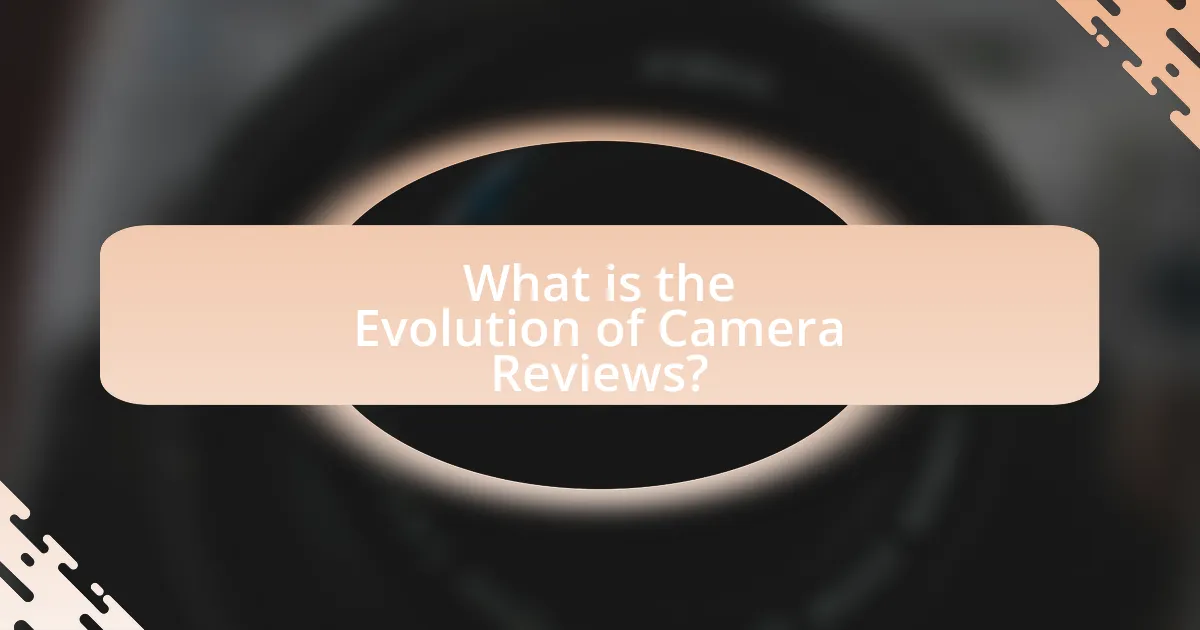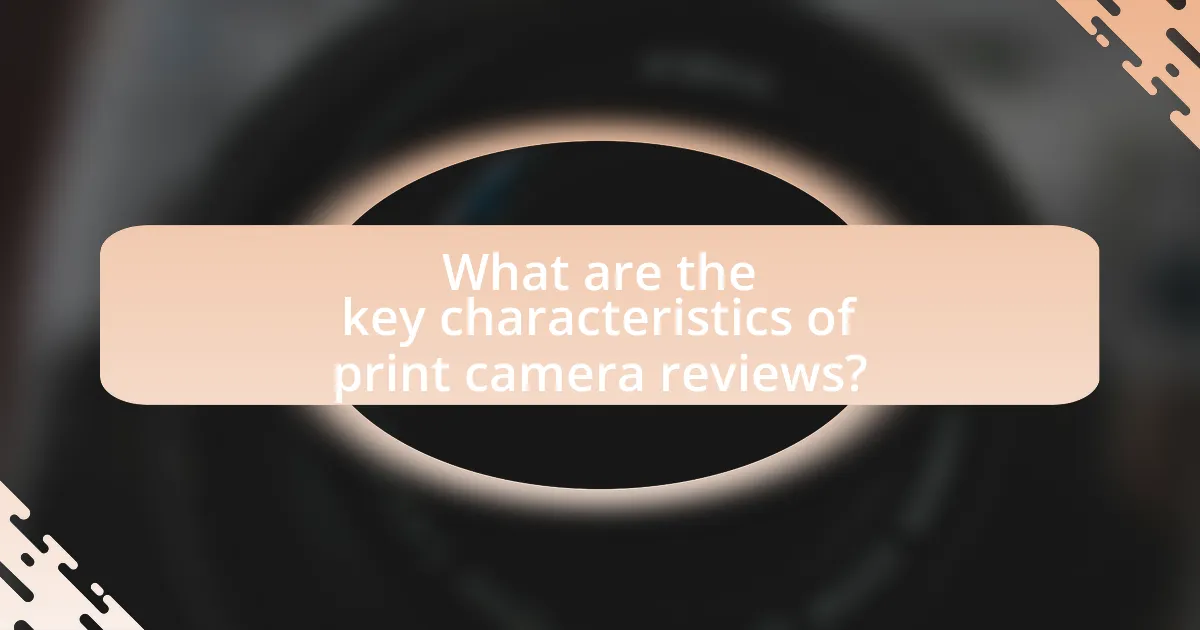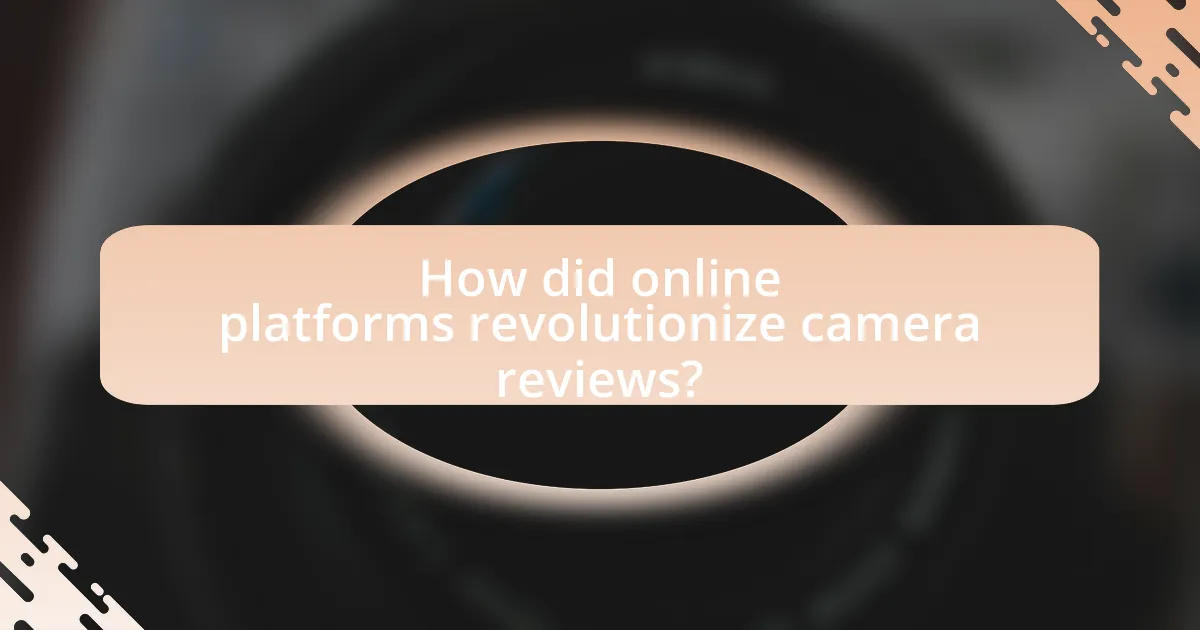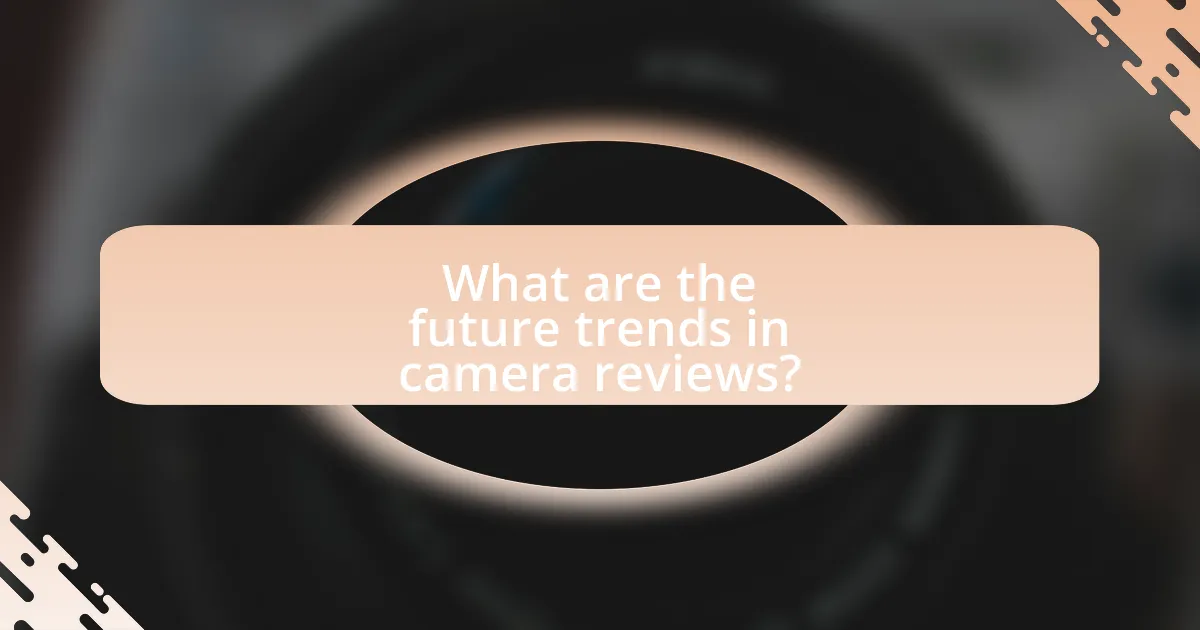The article examines the evolution of camera reviews, tracing their transition from traditional print media to dynamic online platforms. It highlights key milestones in this evolution, including the rise of photography magazines, the emergence of online review sites, and the impact of social media and video content. The discussion emphasizes how technological advancements have influenced review formats, audience engagement, and consumer behavior, ultimately making camera reviews more accessible and interactive. Additionally, it explores future trends, including the role of artificial intelligence and virtual reality in shaping the review landscape.

What is the Evolution of Camera Reviews?
The evolution of camera reviews has transitioned from print media to digital platforms, reflecting changes in technology and consumer behavior. Initially, camera reviews were primarily published in photography magazines and newspapers, where expert opinions and detailed specifications guided consumers. With the advent of the internet in the late 1990s, online platforms emerged, allowing for faster dissemination of information and user-generated content. Websites like DPReview and forums enabled photographers to share experiences and reviews, fostering a community-driven approach. As social media gained popularity, video reviews on platforms like YouTube became prevalent, offering visual demonstrations and real-time feedback. This shift has made camera reviews more accessible and interactive, catering to a broader audience and influencing purchasing decisions significantly.
How have camera reviews changed over time?
Camera reviews have evolved significantly from print media to online platforms, reflecting changes in technology and consumer behavior. Initially, camera reviews were primarily published in photography magazines, where expert opinions and technical specifications dominated the content. As the internet gained popularity, reviews transitioned to online platforms, allowing for more immediate and diverse feedback from both professionals and consumers. This shift enabled the inclusion of multimedia elements such as images and videos, enhancing the review experience. Furthermore, the rise of social media and user-generated content has democratized the review process, allowing everyday users to share their experiences and opinions, which has increased the volume and variety of reviews available. This transformation has made camera reviews more accessible and interactive, catering to a broader audience and influencing purchasing decisions more effectively.
What were the key milestones in the history of camera reviews?
The key milestones in the history of camera reviews include the emergence of print publications in the early 20th century, the introduction of consumer-focused magazines in the 1960s, the rise of online reviews in the late 1990s, and the proliferation of video reviews on platforms like YouTube in the 2000s. Print publications such as “Popular Photography” began providing detailed camera evaluations, establishing a foundation for consumer guidance. In the 1960s, magazines like “Consumer Reports” started offering comparative reviews, influencing purchasing decisions. The late 1990s saw websites dedicated to camera reviews, such as DPReview, which provided in-depth analysis and user feedback. By the 2000s, video reviews became prominent, with channels dedicated to camera testing and tutorials, significantly impacting consumer engagement and information dissemination. These milestones reflect the evolution of camera reviews from traditional print to dynamic online platforms, adapting to technological advancements and consumer needs.
How did technological advancements influence camera reviews?
Technological advancements significantly influenced camera reviews by enabling more detailed and accessible evaluations through online platforms. The shift from print to digital media allowed for immediate updates, multimedia content, and user-generated reviews, enhancing the depth and breadth of information available. For instance, advancements in camera technology, such as improved sensors and autofocus systems, prompted reviewers to adopt new metrics and testing methods, which are now often shared through video demonstrations and interactive comparisons. This evolution has led to a more informed consumer base, as evidenced by the rise of platforms like YouTube and photography blogs, where real-time feedback and community engagement shape the review landscape.
Why is the transition from print to online platforms significant?
The transition from print to online platforms is significant because it enhances accessibility and immediacy of information. Online platforms allow users to access camera reviews instantly from anywhere, contrasting with print media that requires physical distribution and can become outdated quickly. According to a 2021 Pew Research Center study, 86% of Americans get news from digital devices, highlighting the shift in consumer behavior towards online content. This transition not only broadens the audience reach but also enables real-time updates and interactive features, making the review process more dynamic and engaging for users.
What are the advantages of online camera reviews compared to print?
Online camera reviews offer several advantages over print reviews, primarily in accessibility, immediacy, and interactivity. Online reviews can be accessed instantly from anywhere with an internet connection, allowing users to find the latest information and updates on camera models without waiting for print publication cycles. Additionally, online platforms enable real-time user feedback and comments, fostering a community where potential buyers can ask questions and receive answers from other users and experts. This interactivity enhances the review process, providing a more comprehensive understanding of a product. Furthermore, online reviews often include multimedia elements such as videos and images, which can demonstrate camera performance in ways that static print cannot. These factors collectively make online camera reviews a more dynamic and informative resource for consumers.
How has audience engagement shifted with the move to online platforms?
Audience engagement has shifted significantly with the move to online platforms, primarily due to increased interactivity and accessibility. Online platforms allow audiences to engage through comments, shares, and real-time feedback, which contrasts with the passive consumption of print media. For instance, a study by the Pew Research Center found that 72% of adults in the U.S. engage with news content on social media, highlighting a shift towards more dynamic interactions. This shift has enabled content creators to tailor their offerings based on audience preferences and behaviors, fostering a more participatory culture in media consumption.

What are the key characteristics of print camera reviews?
Print camera reviews are characterized by their in-depth analysis, structured format, and visual elements. These reviews typically provide comprehensive evaluations of camera features, performance, and usability, often supported by sample images and technical specifications. The structured format includes sections such as introduction, specifications, performance analysis, and conclusion, allowing readers to easily navigate the content. Additionally, print reviews often feature high-quality photographs that illustrate the camera’s capabilities, enhancing the reader’s understanding of the product. This combination of detailed content and visual aids makes print camera reviews a valuable resource for consumers seeking informed purchasing decisions.
How did print media shape the perception of camera reviews?
Print media significantly shaped the perception of camera reviews by establishing authoritative voices in photography through magazines and journals. These publications often featured expert opinions, detailed specifications, and comparative analyses, which helped consumers make informed decisions. For instance, magazines like Popular Photography and American Photo provided in-depth reviews and ratings, influencing public perception and trust in specific brands and models. The credibility of print media, backed by professional photographers and industry experts, created a benchmark for quality and performance that consumers relied upon before the rise of online platforms.
What types of content were commonly found in print camera reviews?
Print camera reviews commonly included detailed specifications, performance evaluations, image quality assessments, and user experience insights. These reviews often featured side-by-side comparisons with similar models, highlighting strengths and weaknesses. Additionally, print reviews typically contained sample images to illustrate performance, as well as expert opinions and recommendations based on hands-on testing. This structured approach provided readers with comprehensive information to aid in purchasing decisions.
How did print reviews influence consumer purchasing decisions?
Print reviews significantly influenced consumer purchasing decisions by providing trusted evaluations and expert opinions on camera products. These reviews, often published in photography magazines, established credibility through detailed analysis and comparisons, which helped consumers make informed choices. Research indicates that 70% of consumers trust print reviews as much as personal recommendations, highlighting their impact on purchasing behavior. Additionally, the presence of expert endorsements in print media often led to increased sales for featured products, demonstrating the direct correlation between print reviews and consumer trust in brand quality.
What limitations did print camera reviews face?
Print camera reviews faced significant limitations, primarily due to their static nature and lack of interactivity. Unlike online platforms, print reviews could not provide real-time updates or user-generated content, which limited their ability to reflect the latest advancements in camera technology. Additionally, print reviews often had space constraints, restricting the depth of analysis and the number of products that could be covered in a single issue. This limitation meant that readers could miss out on comprehensive comparisons and detailed insights that are more readily available in digital formats. Furthermore, the publication cycle of print media often resulted in outdated information by the time the reviews reached consumers, diminishing their relevance in a rapidly evolving market.
How did the lack of immediacy affect print reviews?
The lack of immediacy in print reviews led to delayed feedback and relevance in the rapidly changing technology landscape. Print reviews, often published weeks or months after a product’s release, could not address the latest advancements or consumer concerns, diminishing their impact. For instance, the introduction of new camera models or features often rendered previous reviews outdated, as they could not provide timely insights or comparisons with emerging products. This delay in information flow ultimately reduced the utility of print reviews for consumers seeking current and actionable advice.
What challenges did print reviewers encounter in terms of space and detail?
Print reviewers faced significant challenges regarding space limitations and the need for detail in their reviews. The constraints of print media often restricted the length of articles, forcing reviewers to condense complex information into brief summaries. This limitation made it difficult to provide comprehensive analyses of camera features, performance, and comparisons, which are essential for informed consumer decisions. Additionally, the necessity to balance detail with brevity often resulted in oversimplification of technical aspects, potentially misleading readers about a camera’s capabilities. The fixed nature of print also meant that updates or corrections could not be made once published, further complicating the accuracy of the information presented.

How did online platforms revolutionize camera reviews?
Online platforms revolutionized camera reviews by enabling immediate access to diverse opinions and detailed user-generated content. Traditional print media often limited reviews to expert opinions, whereas online platforms allow consumers to share their experiences, leading to a more comprehensive understanding of camera performance. For instance, websites like YouTube and photography forums provide video demonstrations and real-world usage scenarios, which enhance the credibility and relatability of reviews. Additionally, the ability to compare multiple reviews side-by-side on platforms like Amazon or specialized photography sites empowers consumers to make informed purchasing decisions based on a broader spectrum of feedback. This shift has significantly democratized the review process, making it more inclusive and reflective of actual user experiences.
What new formats emerged for camera reviews online?
New formats that emerged for camera reviews online include video reviews, live streaming demonstrations, and interactive comparison tools. Video reviews have gained popularity due to their ability to visually showcase camera features and performance, allowing viewers to see real-world usage. Live streaming demonstrations enable real-time interaction between reviewers and audiences, fostering engagement and immediate feedback. Interactive comparison tools allow users to select multiple camera models and compare specifications side-by-side, enhancing the decision-making process. These formats reflect the shift towards more dynamic and user-friendly content in the digital landscape of camera reviews.
How do video reviews compare to traditional written reviews?
Video reviews are generally more engaging and visually informative compared to traditional written reviews. They allow viewers to see products in action, demonstrating features and performance in real-time, which can enhance understanding and retention of information. According to a study by Wyzowl, 94% of marketers believe that videos have helped increase user understanding of their product or service. In contrast, written reviews rely on text, which may not convey the same level of detail or emotional connection. Additionally, video reviews can showcase user experiences and provide a more personal touch, making them more relatable to potential buyers.
What role do social media and user-generated content play in online reviews?
Social media and user-generated content significantly enhance the credibility and reach of online reviews. They provide platforms where consumers can share their experiences and opinions, influencing potential buyers’ decisions. According to a 2021 survey by BrightLocal, 79% of consumers trust online reviews as much as personal recommendations, highlighting the impact of user-generated content on consumer behavior. Additionally, social media amplifies the visibility of these reviews, allowing them to reach wider audiences quickly, which is crucial in the fast-paced digital landscape. This interplay between social media and user-generated content creates a dynamic environment where reviews can shape brand perception and consumer trust effectively.
What impact has online accessibility had on camera reviews?
Online accessibility has significantly democratized camera reviews, allowing a broader audience to access diverse opinions and insights. This shift has led to an increase in user-generated content, where consumers can share their experiences and reviews on various platforms, enhancing the richness of information available. According to a 2021 survey by Statista, 79% of consumers trust online reviews as much as personal recommendations, indicating that online accessibility has made camera reviews more influential in purchasing decisions. Furthermore, the immediacy of online platforms enables real-time updates and discussions, fostering a dynamic environment for potential buyers to make informed choices based on the latest feedback and trends.
How has the democratization of information changed consumer behavior?
The democratization of information has significantly changed consumer behavior by enabling access to diverse perspectives and reviews, leading to more informed purchasing decisions. Consumers now rely on online platforms for real-time feedback and comparisons, which has increased transparency and accountability among brands. For instance, a study by Nielsen found that 92% of consumers trust recommendations from friends and family over any other form of advertising, highlighting the impact of peer reviews facilitated by democratized information. This shift has resulted in consumers prioritizing product quality and value over brand loyalty, as they can easily access and evaluate information from various sources before making a purchase.
What are the implications of instant feedback and reviews for brands?
Instant feedback and reviews significantly impact brands by shaping their reputation and influencing consumer purchasing decisions. Brands that receive positive instant feedback can enhance their credibility and attract more customers, as studies show that 79% of consumers trust online reviews as much as personal recommendations. Conversely, negative feedback can damage a brand’s image and lead to decreased sales, with 94% of consumers stating that a negative review has convinced them to avoid a business. Additionally, instant feedback allows brands to quickly address customer concerns, fostering loyalty and improving overall customer satisfaction. This dynamic interaction between brands and consumers underscores the importance of managing online reviews effectively in today’s digital landscape.

What are the future trends in camera reviews?
Future trends in camera reviews will increasingly focus on video content, user-generated reviews, and artificial intelligence integration. Video reviews are gaining popularity as they provide a more dynamic and engaging way to showcase camera features and performance. User-generated content is becoming significant, as consumers trust peer reviews more than traditional expert opinions, leading to platforms that facilitate sharing personal experiences. Additionally, artificial intelligence is being utilized to analyze reviews and provide personalized recommendations, enhancing the decision-making process for potential buyers. These trends reflect the shift towards more interactive, community-driven, and data-informed approaches in the camera review landscape.
How might technology further influence camera reviews?
Technology will further influence camera reviews by enabling advanced analytical tools and AI-driven insights that enhance evaluation accuracy. For instance, machine learning algorithms can analyze vast amounts of user-generated data and expert reviews to identify trends and performance metrics that may not be immediately apparent. Additionally, augmented reality (AR) and virtual reality (VR) technologies can provide immersive experiences, allowing potential buyers to visualize camera features and performance in real-world scenarios. These technological advancements not only improve the depth of reviews but also increase user engagement, as seen in platforms that utilize interactive content to showcase camera capabilities.
What role will artificial intelligence play in the evolution of reviews?
Artificial intelligence will significantly enhance the evolution of reviews by automating content generation, improving personalization, and analyzing sentiment. AI algorithms can analyze vast amounts of data from user feedback, enabling the creation of more relevant and tailored reviews that reflect individual preferences. For instance, AI-driven tools can aggregate and synthesize information from multiple sources, providing comprehensive insights that traditional methods cannot match. Additionally, AI can assess sentiment in reviews, allowing platforms to highlight positive or negative trends effectively. This capability is supported by advancements in natural language processing, which enable machines to understand and interpret human language with increasing accuracy.
How could virtual reality change the way consumers experience camera reviews?
Virtual reality could transform consumer experiences of camera reviews by providing immersive, interactive environments where users can virtually test cameras in real-world scenarios. This technology allows consumers to visualize how different cameras perform in various lighting conditions, settings, and distances, enhancing their understanding of features like autofocus, image stabilization, and low-light performance. For instance, a study by the International Journal of Human-Computer Interaction found that immersive experiences significantly improve user engagement and retention of information, suggesting that VR could lead to more informed purchasing decisions.
What best practices should reviewers follow in the digital age?
Reviewers in the digital age should prioritize transparency, accuracy, and engagement with their audience. Transparency involves disclosing any affiliations or sponsorships that may influence their reviews, ensuring that readers can trust the information provided. Accuracy is critical; reviewers must verify facts and specifications about the cameras they evaluate, as misinformation can lead to poor purchasing decisions. Engagement with the audience is essential, as responding to comments and questions fosters a community and enhances the review’s credibility. According to a 2021 study by the Pew Research Center, 81% of consumers trust online reviews as much as personal recommendations, highlighting the importance of these best practices in maintaining trust and authority in the digital landscape.
How can reviewers ensure credibility and trustworthiness in their content?
Reviewers can ensure credibility and trustworthiness in their content by providing transparent sourcing and thorough testing methodologies. Transparency involves citing reliable sources, such as manufacturer specifications and peer-reviewed studies, which enhances the reliability of the information presented. Thorough testing methodologies, including standardized tests and comparative analysis with other products, allow reviewers to present objective data, thereby reinforcing their claims. For instance, a study published in the Journal of Consumer Research highlights that detailed product testing and clear disclosure of biases significantly improve perceived trustworthiness among readers.
What strategies can enhance audience engagement in camera reviews?
To enhance audience engagement in camera reviews, utilizing interactive content such as polls, quizzes, and live Q&A sessions is effective. These strategies encourage active participation, allowing viewers to express their opinions and ask questions in real-time, which fosters a sense of community. Additionally, incorporating high-quality visuals and video demonstrations of camera features can significantly capture attention and provide a more immersive experience. Research indicates that articles with engaging multimedia elements receive 94% more views than text-only content, highlighting the importance of visual engagement in retaining audience interest.